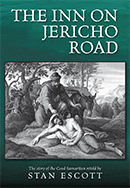WATCHWORD:
Via Dolorosa
11 Meanwhile Jesus stood before the governor, and the governor asked him, “Are you the king of the Jews?” “You have said so,” Jesus replied. 12 When he was accused by the chief priests and the elders, he gave no answer. 13 Then Pilate asked him, “Don’t you hear the testimony they are bringing against you?” 14 But Jesus made no reply, not even to a single charge—to the great amazement of the governor. 15 Now it was the governor’s custom at the festival to release a prisoner chosen by the crowd.
16 At that time they had a notorious prisoner whose name was Jesus Barabbas. 17 So when the crowd had gathered, Pilate asked them, “Which one do you want me to release to you: Barabbas, or Jesus who is called the Messiah?” 18 For he knew it was out of self-interest that they had handed Jesus over to him. 19 While Pilate was sitting on the judge’s seat, his wife sent him this message: “Don’t have anything to do with that innocent man, for I have suffered a great deal today in a dream because of him.” 20 But the chief priests and the elders persuaded the crowd to ask for Barabbas and to have Jesus executed. 21 “Which of the two do you want me to release to you?” asked the governor. “Barabbas,” they answered. 22 “What shall I do, then, with Jesus who is called the Messiah?” Pilate asked. They all answered, “Crucify him!” Matthew 27:11-22
Jerusalem: The Via Dolorosa (Latin for “Sorrowful Way”, often translated “Way of Suffering) is a processional route in the Old City of Jerusalem, believed to be the path that Jesus walked on the way to his crucifixion. The winding route from the former Antonia Fortress to the Church of the Holy Sepulchre, a distance of 2,000 feet, is a celebrated place of Christian pilgrimage. The current route has been established since the 18th century, replacing various earlier versions. It is today marked by nine Stations of the Cross; there have been fourteen Stations since the late 15th century, with the remaining five Stations being inside the Church of the Holy Sepulchre. Wikipedia
Saint John, Indiana: The Shrine of Christ’s Passion is a fair depiction of the Stations of the Cross, with excellent audio explanations at each Station. Last fall a group of us made that odyssey, including two members of our group, Brothers Dan and Stan, and we would testify that this is a very reverent and respectful interpretation of Christ’s final hours as God Incarnate. Do not approach this as entertainment! A visit is well worth the two-hour drive. (Directions: Take US 30 west to US 41, then south 3-4 miles, The Shrine is on your right. Tiebels Restaurant is also worth the drive. Just ask Dan or Stan.)
Via DelaRosa: Way of Suffering, Stations of the Cross, however you might describe Jesus’ final steps leading to Calvary and his crucifixion, it could never capture how painful, and violent those 2000 feet were. The Via Delarosa has been romanticized to the point where the pain and the suffering, and the cruelty, and the bloodletting, have been removed and sanitized for polite and comfort-demanding congregations. The reality is we need to keep afresh the cruelty, the suffering, and the bloodletting, for this is also our way to the Cross, our way to bring our sins and evil, and our wrongdoings, and our cruelty, and our dishonesty to the Cross. Via DelaRosa is Holy Week.
We may casually say, ‘Its Friday, but Sunday is coming’, without considering what that Friday really means, or how all our sins led up to that Friday on The Cross. This week, it is worth a serious thought.
Meditation:
The Way of the Cross comprises 14 Stations. What did arriving at the final Station’ look like? Maybe something like this:
“Barabbas heard a cry and looked. There, two crosses holding men, recently crucified, crying out in their pain. He did not want to be here. He needed to leave. But, before he could move, there was a commotion behind him.
When he turned, it was that other group, and he saw a man staggering up the hill toward him, a heavy wooden beam across to his shoulders. He had been flogged, his back a mass of bloody flesh. It was the same man that had stood beside him with Pilate. Jesus, the man from Nazareth. There were thorns still around his head, like a crown, blood streaked down his face. There was blood on his torn tunic.
As he watched, a woman, tears running down her cheeks, stepped forward and, with a cloth, wiped blood from Jesus’ face. A guard rushed up and roughly pushed her away, she staggered and fell. Jesus reached out a hand, but the guard blocked him. The sight caused Barabbas to turn away in sadness and disgust.
There was that mob of men, following Jesus, laughing, and striking him with scourging whips. Behind them came another man, dragging a long, heavy post. Barabbas realized that these were parts of a cross. It was a sad, awful scene, and, again, he tried to leave, but, now, the crowd surrounded him, blocking his way.”
From A Life for Barabbas
Maybe, we, like Barabbas, do not want to be here, but when we turn to leave, a crowd blocks our way. I would think that the ‘crowd’ that blocks our way is within. The whisper of God telling us, ‘This is the way, dear one, this is My door.’
Closing Prayer:
Father, help us all to see this Holy season of Lent as a time of spiritual renewal, and this period of isolation as a time of redemption, rather than a time of deprivation. Motivate us to reach a new level of experiencing Your grace, facing this day and all those to come, with gratitude to You, Lord and Savior. As in all things, Thy Will be done. Amen.
